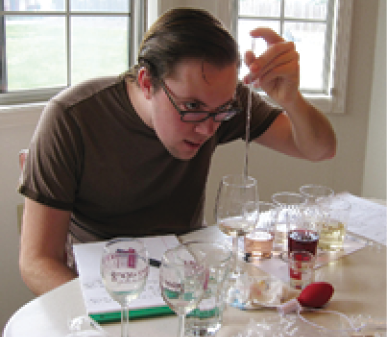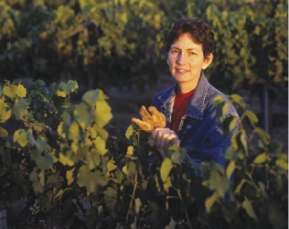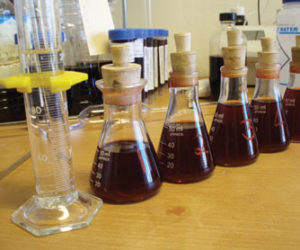 “Blending is a natural procedure, honest, necessary, and in accordance with historical events.”
“Blending is a natural procedure, honest, necessary, and in accordance with historical events.”
With that quote, eminent wine authority Emile Peynaud gives us permission to play with our wines. While he was addressing grape wine in his classic Knowing and Making Wine, I think his sentiment applies even more to the wide, wonderful world of fruit wines. Grapes are among the fruits, of course, but when we say “fruit wine” we generally exclude conventional grape wine. For this “Techniques” column on blending I am extending the exercise across traditional boundaries. Why not blend wines made from grapes and other fruits?
For any wine-blending project, amateur or professional, the winemaker is hoping for a better wine than the components alone. From there, however, the goals of the commercial winemaker diverge somewhat from those of us who make wine at home. For marketing purposes, the commercial winery needs a large enough quantity to be sold in wide distribution. At home, though, we can make little batches of wine just for fun. Very often, commercially blended wines are focused on creating or maintaining a “house” style, so the consumer has clear expectations for each new vintage or release. No such restriction applies when we blend wines for fun! In fact, instead of making a large lot of one wine, home winemakers can use blending to make more lots of different wines. After fermenting alone, the wines can be mixed and matched to make quite different presentations to round out the cellar collection. If you add sweetening as a technique for improving blends, you have even more opportunities.
Trials are essential in achieving a good blend — at home or in a winery — and you might as well enjoy that part of the process, too. Invite winemaking buddies or wine loving friends to taste and blend with you. To help you plan a fruit wine blending project, the key steps are presented below. To provide practical technique information, each step is followed with a discussion of my recently completed blending project.
Your results will be different, but here’s a roadmap to help you find your way.
1. Make some fruit wines
For a blending project, you will want to make at least three or four different kinds. I started on my fruit wines in October. At the Marin Farmers Market in San Rafael, California, my wife Marty White and I went looking for late-season fruit. We came home with melons to make a mixed-melon wine: two Canary melons and three Moon and Stars melons. We also found pomegranates and Sweet September peaches. Fruits are often lower in acid than grapes, usually lower in sugar, and generally not as juicy when it comes to yields. For my melon, peach, and pomegranate wines, I supplemented the fermentables with corn sugar prior to pitching yeast. Since fruit wines are not usually in the “blockbuster” category, I was only looking for about 20 °Brix to achieve 11 to 12 percent alcohol. The pomegranate must had a high enough acid level that no supplementation was needed. For the melon and peach wines, I added tartaric acid to achieve about 5 g/L titratable acidity in the finished mix. All three wines fermented over the course of a few weeks. The pomegranate wine cleared on its own, although it came out much paler in color than I anticipated; pink rather than red. The melon and peach wines remained cloudy after fermentation so I fined both of them with Sparkolloid and they cleared up nicely. I maintained sulfite levels at about 30 ppm free SO2 during aging to prevent oxidation and spoilage. All were kept in topped up carboys: 5 gallons (19 L) of peach wine, 5 gallons (19 L) of melon wine, and 3 gallons (11 L) of pomegranate wine. All finished completely dry. Hydrometer measurements showed the melon wine at -3.0 °B, the peach at -2.0 °B, and the pomegranate at -1.8 °B.
For some grape wines to use in blending, I turned to my in-progress 2013 homegrown wines. Although I put the bulk of my Chardonnay through malolactic fermentation, I kept a couple of carboys aside without malolactic this year specifically for use in blends. The Pinot Noir for blending was part of the main batch and had undergone malolactic fermentation and had spent some time in barrel. Because I make 40 or 50 gallons of each of these wines every year, there was essentially no limit on how much I could use for blending.
2. Plan your blending trials
With your fruit wines stable and ready, ask yourself: Do I want just one blend, or several? Will I consider sweetening? If wine is left over, how will I use it?
After answering these questions, set up blending trials and assess each of your blend components. As with any critical tasting of wine, you want to examine the color, aroma, flavor, and mouthfeel of each possible partner in a blend. Part of planning also concerns how much wine you will need for trials. I usually try to provide at least a half pint — 8 ounces/240 mL — of each wine for every participant in the blending trials. You will also need to decide if you want to try sweetening. I definitely recommend this as one of your trial tools since a modest level of sweetening often makes fruit wines seem much “fruitier.” A convenient way to add sugar for trials is to make a standard solution. First, weigh out 50 g (about 2 ounces) of sucrose (cane or beet sugar) and place it in a small saucepan. Add 50 mL (also about 2 ounces) of distilled water and bring to a boil. Stir to dissolve. After boiling briefly, cover the pot and place it in an inch or two of cold water in the kitchen sink to cool. When the sugar syrup is completely cool, transfer it to a 100 mL volumetric flask, graduated cylinder, or graduated beaker. Dilute to exactly 100 mL with distilled water. Now you have a sugar solution that contains 50 g of sugar in 100 mL of solution, or 0.5 g in every milliliter. For trials, it is easy to make 1, 2, or 3% additions: for a 50-mL (2-oz.) wine sample, adding 1 mL of your sugar solution adds 0.5 g or exactly 1% (weight/volume) of sugar. Using a small pipet or syringe, adding increments of 1, 2, 3 or even more mL of sugar solution gives you controlled and known sweetening additions to your wine. If you find a level you like, you can adjust the main batch accordingly (more on that, below).
Arrange for each taster to have several wine glasses for mixing and evaluating blends. For convenient access to the source wines, you can pour a few ounces of each wine into clear plastic glasses. Make paper placemats that identify the wines to help people keep them straight as they go along. You will also need to provide graduated cylinders or beakers and pipets or syringes for measuring wine and additions. Plan a way to get rid of blends that don’t work — put out a plastic pitcher or small bucket to dump rejects. Provide notebooks so you can collect everyone’s observations when the tasting is over.
For my setup, my Beverage People colleague Alex Ponting joined Marty and me. I collected about a ½ gallon (2 L) of wine in each of five one-gallon (3.8 L) jugs: Peach, pomegranate, melon, Chardonnay, and Pinot Noir. I gassed the remaining wine in the carboys with argon and restoppered them. I would not store wine long-term in a partially filled carboy like that, but I planned to blend and bottle the wines the day after the tasting. I prepared a sugar solution and made paper placemats with the five wine names positioned on them. Place settings included plastic glasses for the starting wines, stemmed glasses for tasting blends, and a water glass for each of us.
3. Do the trials
Tell everyone to think freely and to take notes on whatever they do. Point out the various measurement equipment you have provided. Carefully explain the standard sugar solution and how measured sweetening can be done. At the beginning, have everyone taste all of the base wines individually and discuss them. One wine may offer more acid, while another may emphasize fruity character. As you talk about the wines, try to imagine how they might complement or contrast with one another in blends. After that, turn your tasters loose. Let them blend, swirl, taste, and take notes.
Alex, Marty, and I tasted our component wines and made some observations:
Melon: This wine had a distinct melon aroma, verging a little to the vegetable side, like a freshly cut cucumber. It tasted a bit like a sweet cucumber, too. Other subtle notes in this mild, pale wine included smoke and peat, along with a peppery finish.
Peach: Very pretty with a pale peach color, it provided light peachy aromas and notable peachy flavor. The flavors lingered through a long finish.
Pomegranate: This wine was pale, a delicate shell pink. It had winey or vinous aromas, but not much fruitiness. From the natural acidity of the fruit, it finished with a bit of a sharp bite.
Chardonnay: Typical varietal aromas were supplemented with some light grapefruit notes. It was noticeably bright and acidic in flavor, even lemony. Reflecting the cool-climate growing conditions and no malolactic treatment, it could contribute refreshing acidity to any blend.
Pinot Noir: The nose revealed the recent barrel aging, with vanilla and oak overlaying the mild fruitiness. Flavors followed on the red fruit plan, revealing notes of cherry and strawberry. On the finish, it had a lingering richness and a fuller mouthfeel than the other blend components. The most intensely colored of our base wines; we could count on it to bring a nice pink color to blends.
Alex made nine different combinations with two or three components each. He sweetened several of them, sometimes trying progressively higher sugar levels on the same blend. Marty prepared eight blends, also generally with two or three components. She was adventurous with the sweetening, going as high as 6.5% on one trial. I made a dozen blends, most of them with just two components. I tried several 50/50 combinations to help identify what each wine brought to the blending results. Finally, I couldn’t resist the kitchen-sink approach: I made a blend that was 20% each of all five base wines.
4. Discuss and report
As everyone wraps up their trials, probably in an hour or less, ask them to look over their notes. Bring up and discuss any especially successful blends or any that didn’t work. Have each participant choose one or two favorite blends and make a larger sample of that same blend to share. Have everyone taste these winners and evaluate them.
For our blends, Alex’s favorite was 10% Chardonnay, 30% melon, and 60% peach, sweetened to 0.5% residual sugar. This wine boasted a nice fruit basket mixed aroma and a fruity, white wine-like flavor profile. When Alex tried the same blend with 1% sugar instead, he found that it suppressed the fruitiness. His second choice was 90% peach and 10% Chardonnay, also with 0.5% sugar. This wine was pleasant, but less complex and not as enjoyable as his first choice.
Marty presented the sweet blend mentioned above: 50% Chardonnay and 50% peach with 6.5% sugar. The blend had a bright, lemony aroma and a round, mellow, fruity flavor. It hid its high sugar level very effectively and made a pretty good white wine. Marty’s second presentation was 33% melon and 67% pomegranate with 1.5% sugar. This wine was pale pink in color and showcased the melon aromas and flavors, even though that wine was the minority contributor. It made a very favorable “melon wine” impression on us.
For my best, I first presented a 50/50 melon/peach with no sweetening. All I achieved with it, though, was a good, neutral white wine. My second choice made a better impression: 50/50 Pinot Noir/pomegranate, with 1.0% sugar. This wine benefitted from the tannic support of the Pinot Noir and presented as a very good rosé-type wine in a slightly off-dry style. My five-way equal blend was just muddled and boring.
5. Decide on your production blends
When you have narrowed your potential blends to the choices you like best, it’s time to compare the wine volumes you have with what it will take to make those blends. If one of your favorites takes all of one component, it will rule out using that component in any others. To deal with those constraints, make a chart that shows the percentages of the wines you like best and the amount available. From that, you can decide how much to dedicate to each choice. Ultimately, you may need to come up with a “leftover” choice to use up all the wine at bottling.
For my blends, I chose Alex’s Chardonnay/melon/peach combination, Marty’s melon/pomegranate, and my pomegranate/Pinot Noir. Accounting for the removal of the tasting samples, I had left about 4.5 gallons (17 L) of peach wine, 4.5 gallons (17 L) of melon, and 2.3 gallons (8.7 L) of pomegranate. I could use any amount I wanted of Chardonnay and Pinot Noir. Because arithmetic is easier with metric calculations, I translated my volumes into liters.
My potential chart looked like this:
There is no competition for the peach wine; it can all go into the Alex blend. If we use all 17 L of that, it takes along 8.5 L of melon and 2.8 L of Chardonnay. Because the amount of pomegranate wine was so small, I decided to put it all in Marty’s blend instead of splitting it. Assigning all 8.7 L there, the rest of the blend takes 4.4 L of melon, left over after Alex’s portion. I could make two of the top choices. At that point, though, I needed to deal with leftovers. All I have is the remaining 4.1 L of melon, plus Chardonnay and Pinot Noir. Looking back through my notes, I found that my original third choice had been 50/50 melon/Chardonnay, unsweetened. I had rejected it because it was a bit boring; another generic white wine profile. To use up the leftovers, though, that sounded just fine.
6. Blend and bottle
First, calculate your volumes. Plan any sugar additions, weigh out the sugar you need, and boil it in an equal amount of distilled water to sterilize and dissolve. Make sure you have a bottling bucket big enough for your biggest blend cleaned and sanitized. For any sweetened blends, calculate potassium sorbate additions to prevent refermentation after bottling; about one gram per gallon. A large plastic beaker with a handle — two or three liters — can be very helpful to measure portions. Sanitize the beaker, siphon wine into it, and pour gently into the bucket for blending. Using a sanitized stainless steel spoon, mix in any sugar syrup and sorbate. Fill and cork bottles as usual.
For my blends, I started with Alex’s wine since it was the largest volume. Using a 10-gallon (38-L) bucket, I mixed all 17 L of peach wine with 8.5 L of melon and 2.8 L of Chardonnay. With 17 + 8.5 + 2.8 = 28.3 L, a 0.5% sweetening needed (28.3 x 0.5/100) = 0.14 kg or 140 g of sugar. I boiled that up with 140 mL of distilled water and stirred it in along with 7.5 g of potassium sorbate. I filled and corked the bottles of the first blend and then followed the same procedure for the other blends before labeling all of the wines with depictions of their fruits.







